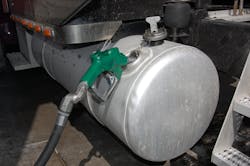National retail average pump prices for diesel and gasoline continued dropping this week, according to data tracked by the Energy Information Administration (EIA), with gasoline falling under $3 a gallon for the first time in over four years.
Diesel dropped 1.2 cents this week to a national average of $3.623 per gallon, the agency reported, which is 23.4 cents per gallon cheaper compared to the same week in 2013.
The Midwest is the only region of the country to report an increase in diesel prices this week – up 1.3 cents to $3.624 per gallon – with prices declining everywhere else, EIA noted.
The Central Atlantic reported the biggest one-week drop in diesel – down 3.8 cents to $3.655 per gallon – followed by New England with a 3.7 cent dip to $3.687.
The Gulf Coast remains home to the cheapest diesel in the U.S., down 3.1 cents for the week at $3.532 per gallon, with the Lower Atlantic hard on its heels with a 2.2 cent drop to $3.533 per gallon.
The national average for gasoline decreased 6.3 cents to $2.993 per gallon this week, EIA said, which is 27.2 cents per gallon cheaper compared to the same week in 2013.
Gasoline remains over $3 per gallon in only four regions of the country: the West Coast, down 8.7 cents to $3.237 (which changes to a 1.2 cent dip to $3.128 with California removed); New England, down 7.4 cents to $3.117; the Rocky Mountains, down 5.7 cents to $3.14; and the Central Atlantic, down 5 cents to $3.071.
Even as fuel prices fall in the U.S., the nation is exporting record levels of crude oil, EIA noted.
The U.S. exported 401,000 barrels per day (bbl/d) of crude oil in July this year, the agency said, which is the highest level of exports in 57 years and the second highest monthly export volume since 1920, when EIA started publishing data.
As a result of existing U.S. crude oil export restrictions, most U.S. crude exports are sourced domestically and are sent only to Canada, the agency pointed out.
However, since April, EIA aid crude exports have included modest amounts of Canadian-produced barrels that were moved through the U.S. to the Gulf Coast and then re-exported to Switzerland, Spain, Italy, and Singapore.
The agency added that it’s “unclear” if this recent trend of Canadian oil re-exports from the Gulf Coast will continue, and if so, for how long.
Several proposed Canadian pipeline projects may provide producers with alternative routes for delivering crude to markets beyond North America, but the timing of each of them is uncertain, EIA noted.
About the Author
Sean Kilcarr
Editor in Chief
Sean Kilcarr is a former longtime FleetOwner senior editor who wrote for the publication from 2000 to 2018. He served as editor-in-chief from 2017 to 2018.
